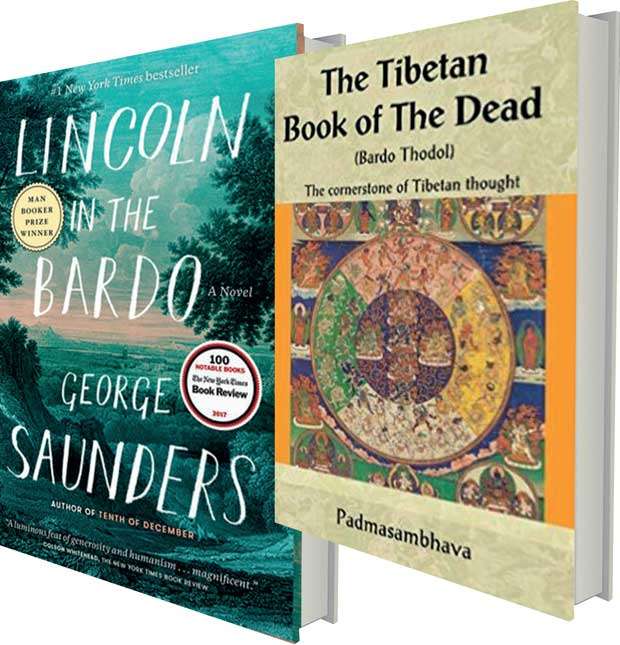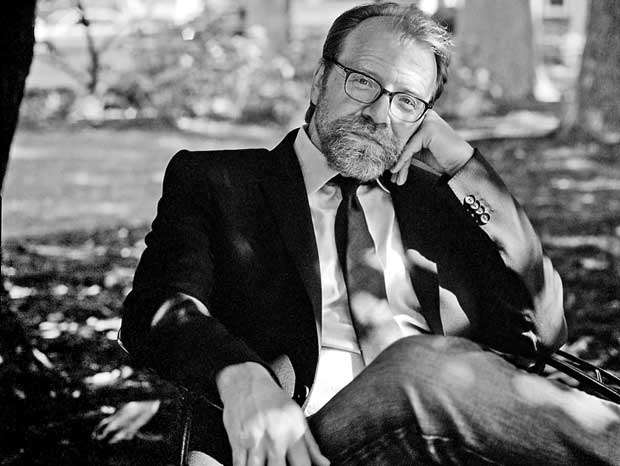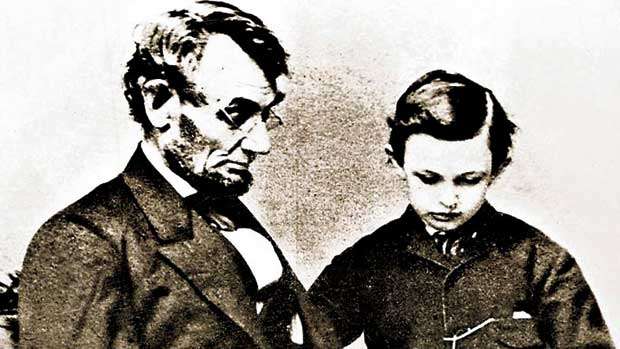16 Nov 2018 - {{hitsCtrl.values.hits}}

 he 2017 Man Booker Prize winning novel ‘Lincoln in the Bardo’ by American fiction writer George Saunders is almost entirely peopled by corpses lying in coffins in the Oak Hill Cemetery in Georgetown, Washington DC on a February night in 1862. The text reads like a film or drama script that comprises an assortment of conversations among the shades of some recently dead and a biographical scrap book about Abraham Lincoln, the 16th president of America, containing diary entries, and extracts from actual and invented historical accounts of the American Civil War period (1861-65), which are carefully attributed to sources.
he 2017 Man Booker Prize winning novel ‘Lincoln in the Bardo’ by American fiction writer George Saunders is almost entirely peopled by corpses lying in coffins in the Oak Hill Cemetery in Georgetown, Washington DC on a February night in 1862. The text reads like a film or drama script that comprises an assortment of conversations among the shades of some recently dead and a biographical scrap book about Abraham Lincoln, the 16th president of America, containing diary entries, and extracts from actual and invented historical accounts of the American Civil War period (1861-65), which are carefully attributed to sources.
The action centres round the crypt of William Wallace Lincoln (Willie), the latest arrival in the graveyard, the recently dead eleven-year-old third son of the president. An interesting fact is that all these ghosts are unaware that they are dead, and behave as if they are alive. ‘Lincoln in the Bardo’ records a mighty struggle between a group of wrangling ghosts over the ‘soul’ of Willie. The only two living characters who appear in this ghostly drama are the gravedigger (or the night watchman) and Abraham Lincoln, the bereaved father. The struggle among the ghosts may be seen as a reflection of the agitated state of grief-stricken Abraham Lincoln’s own mind. In my opinion as a common reader, the novel’s most striking feature is this unconventional device for communicating the central experience of the novel, the most dominant aspect of which is the spiritual enlightenment that the senior Lincoln achieved in coming to terms with the loss of his beloved son. The mixture of bawdy humour and philosophical reflection makes the narrative a realistic and unsentimental comment on the human condition.
Abraham Lincoln, the bereaved father. The struggle among the ghosts may be seen as a reflection of the agitated state of grief-stricken Abraham Lincoln’s own mind. In my opinion as a common reader, the novel’s most striking feature is this unconventional device for communicating the central experience of the novel, the most dominant aspect of which is the spiritual enlightenment that the senior Lincoln achieved in coming to terms with the loss of his beloved son. The mixture of bawdy humour and philosophical reflection makes the narrative a realistic and unsentimental comment on the human condition.
The most loquacious among the wraiths are the three known by the names of Hans Vollman, Roger Bevins III, and Reverend Everly Thomas, who also feature most prominently in the narrative. The shade of Hans Vollman, who was a printer, a middle-aged man married to an eighteen year old bride, goes about naked with a dent on his forehead caused by a falling roof beam that killed him, and a distended male organ that resulted from his death occurring just before he was able to consummate his marriage; he is ‘bearing his tremendous member in his hands, so as not to trip himself on it’, as fellow ghost Roger Bevins III comments. The ghostly body of Roger Bevins III, a gay young man who killed himself, is covered with multiple sets of eyes and hands that perhaps indicate posthumous frustration caused by lusts unsatisfied in life; the spirit of Reverend Everly Thomas is in dread of his impending judgement. The ghosts don’t admit to themselves that they are dead. They are adamant that they are only sick and are lying in what they insist are their ‘sick-beds’ (coffins) in a ‘hospital yard’ (cemetery) awaiting imminent recovery. They tarry in this situation out of their attachment to their previous lives. Freshly arrived Willie wants to stay here eager for visits from his father. The ghosts must encounter a mysterious ‘matterlightblooming’ phenomenon that escorts them to a terrible judgement. They are in the ‘bardo’, a transit station during their passage to their next life. What is this ‘Bardo’ that appears in the title?

The word ‘Bardo’ is taken from Tibetan Buddhism, where it refers to an intermediate plane between the death and the reincarnation of an individual. The name of the Tibetan language book composed by Guru Padmasambhava of the 8th century which used to be known to the West as the ‘Tibetan Book of the Dead’ is ‘Bardo Thodal’. ‘Bardo Thodal’ means ‘The Great Liberation upon Hearing on the Intermediate State’. Actually, the book contains elaborate instructions for a dying person to follow in order to be reborn on a wholesome plane of existence. Something similar to the concept of bardo is known to the Theravada Buddhists of Sri Lanka. It is the metempsychotic state known as the ‘gandhabba’ or transmigration state of consciousness (passing on at death to be reincarnated elsewhere). Saunders is not strictly adopting the authentic bardo or gandhabba idea; he is only adapting it for his fictional purpose.
The folk wisdom expressed in the English ballad ‘The Unquiet Grave’ seems to be present at the back of Saunders’s mind. The ‘Lincoln’ in the title is more Abraham Lincoln than his young son Willie, who is actually in the grave, and has a better claim to be imagined to be in the bardo state. The implication is that Abraham Lincon, the private individual as a distraught parent and the public man shouldering grave responsibilities, particularly at the time of a fratricidal civil war, as president of America, finds himself in his own bardo, too. This is not surprising when we realise that, through his novel, Saunders temporarily consigns not only himself, but also the reader, to the same state of positive inner transformation (equivalent to the Buddhist concept of ‘transmigration’ of personality or consciousness at the time of death).
"The book contains elaborate instructions for a dying person to follow in order to be reborn on a wholesome plane of existence. Something similar to the concept of bardo is known to the Theravada Buddhists of Sri Lanka"
‘Lincoln in the Bardo’ is the efflorescence of an idea conceived in Saunders’s creative imagination on hearing in the 1990s a touching detail in the story of how president Lincoln absorbed the shock of his son Willie’s unexpected death of typhoid. What Saunders heard was that Lincoln visited Willie’s crypt alone in the night to hold his son’s lifeless body in his arms. The writer was deeply touched by this piece of information. The circumstances of Willie’s death made his parents’ grief additionally poignant. The Lincolns were in the midst of a customary state dinner in the White House while the boy was dying in a room upstairs. They had wanted to stop the dinner because of their son’s illness, but the doctor assured them that he would soon recover and asked them to go ahead with the party as planned. Lincoln was president; the civil war, still in its first year, was intensifying. Hundreds of young soldiers were dying. People immediately started criticizing the Lincolns for holding parties while their son was mortally ill. The implicit criticism of the president was in fact on a national scale: What was this unfeeling man doing about stopping the civil war that was claiming so many young lives? On the other hand, Lincoln himself realized that thousands of other American parents were experiencing the same agonizing grief that he was feeling over his son’s demise.
Saunders hints at the obviously Buddhistic theme of his novel in a pre-publication telephone conversation (the interview mentioned above) with the ‘Arts and Entertainment’ magazine on February 8, 2017. The book was published six days later on February 14 by Random House, USA. During the phone exchange, Saunders claimed that he wanted to make the novel emotionally compelling, while avoiding the approach of other novelists who produce successful big novels with multi-generational narratives, by which, he confesses, he can’t pull his work off; his own way he describes as ‘making verbal overflow’ (as readers can see demonstrated in ‘Lincoln in the Bardo’), walling himself off within a narrow restricted area. To the interviewer’s suggestion that, if he set out to ‘convey the sadness of losing someone dear’, his strategy was successful, he responds:

“………. For me it was also about that, and you know how a book just writes its way into some other thing than you planned. It was that conundrum that... if I look at my intuitions about things, the one thing that I know is that affection and love comes naturally. In difficult times, I’m sustained by that, I look to that as kind of a bedrock. That seems to be true for most of us. And then, the conditionality of everything. It’s so harsh, the juxtaposition of those two truths: that you love, and that everything is gonna...... [change].”
Saunders says that he, in reaction to this tragic existential contradiction, makes up a kind of New Age reassurance (‘New Age’ refers to a broad movement characterized by alternative approaches to traditional Western culture): “Yeah, but that’s why life is beautiful”. However, he immediately qualifies this, referring to his real life experience of about fifteen minutes of scary uncertainty when one of the engines of a plane he was travelling in stopped working. It was then that he realized to his amazement how ill-prepared he was for such a situation. He adds: “I’m Buddhist and I meditate and everything, but when that happened, it was almost like if you think you’re in really good shape, and you talk yourself into that, and then somebody suddenly leads you on a leash on a 20 mile run. I didn’t realize how off my perception was from reality. In that moment, I saw how ill-prepared I was for death. So I’m trying to figure out a way to engage that stuff without being so depressing that it can’t be taken, but in the thought that, if you could walk right up to that truth, and figure out a way to live joyfully and live safely with it that would be a real spiritual accomplishment.” Here, Saunders is touching on the general thematic preoccupation that characterizes his short fiction. This applies to his first novel ‘Lincoln in the Bardo’ as well.
30 Nov 2024 3 hours ago
30 Nov 2024 4 hours ago
30 Nov 2024 4 hours ago
30 Nov 2024 6 hours ago
30 Nov 2024 9 hours ago